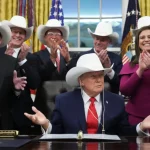
Hope shrivels day by day in west Texas as ranchers facing a drought are selling cattle out of desperation while fearing that the worst is yet to come.
Drought conditions are impacting 97 percent of the state according to Drought Monitor. Although farmers can, in theory, bring in hay from other areas to feed cattle, sky-high energy costs make it too expensive to transport hay. And so they are reducing the herds, according to Local Profile, which wrote, “Last week, USDA meteorologist Brad Rippey reported that 80 percent of Texas’ pastures were in either poor to very poor conditions.”
“Millions of cattle went to slaughter strictly because of the drought because they had nowhere else to go,” rancher Jon Taggart said in a comment to the Forth Worth Star-Telegram, according to Local Profile.
At the Decatur Livestock Market, trucks were recently backed up a mile each way, owner Kimberly Irwin said, according to CBS.
[embedded content]
The 2,600 animals unloaded was a number not seen since the 2011 drought.
“I don’t think it can break quick enough to save me, to tell the truth,” Lee McLachlin of Springtown said.
Irwin said ranchers have a tough decision to make: Sell now or risk animals getting thinner and bringing in even less.
“You know, you want to hang on, but it’s just hard,” Irwin said.
Will this lead to a food shortage eventually?
Yes: 95% (1250 Votes)
No: 5% (62 Votes)
Auctioneer Bryan Forester of Emory said ranchers are reducing their herds, according to KLTV-TV.
Cattle in Texas are being sold at Emory Livestock Auction because of drought …
There will be less meat or none this fall and winter at the grocery stores pic.twitter.com/4HPt9Caf0u— Carol Ray (@CarolRay502000) July 10, 2022
“Drought, fertilizer prices, hay prices, lack of water. Lot of different things factoring in right now,” he said.
“It’s culminated into an unfortunate set of circumstances that farmers and ranchers are having to deal with,” Tracy Tomascik of the Texas Farm Bureau said.
Cotton farmer Lloyd Arthur, who farms land 30 miles from Lubbock, knows all about it, according to the Texas Tribune.
“We can’t outfox what Mother Nature sends us,” Arthur said. “2022 has been one for the record books. We’ve always compared years to 2011, as far as droughts and whatnot, but 2022 is worse. We don’t have any underground moisture.”
“Planting time came and we got a few rains, but they were short-lived rain events,” Arthur said. “It kind of gave us a little false hope. We were so dry, with no moisture underneath, that a lot of the rain did run off.”
“At this point, we’re at triple digits, 20-miles-per-hour winds with humidity — there’s no way this crop can sustain this much longer,” Arthur said.
On some roads near livestock auctions, cattle trailers are lined up as far as you can see. Ranchers are selling cattle because of drought-stricken pastures, a shortage of hay and lack of water.
Read more: https://t.co/sugXXQAnFA
Photos by Emory Livestock Auction, Inc. pic.twitter.com/IkXTjmENdH
— Texas Farm Bureau (@TexasFarmBureau) July 13, 2022
Victor Murphy, climate service program manager for the National Oceanic and Atmospheric Administration, said a drought like that one that hammered Texas in 2011 could be hitting the state.
“It’s a valid fear right now,” said “I’ve been holding off saying that for a while, because parts of the state had good rainfall in May. But seeing June be as dry as it’s been, we’re actually running ahead of 2011 right now.”
“If you go long enough without any rainfall, the ground becomes bone dry,” Murphy said. “So whatever heat comes down, it just radiates back up. I think the state of Texas as a whole right now is very susceptible to that, and that’s what happened in 2011 too.”
Texas is not alone. An estimated 10,000 Kansas cattle died last month as temperatures in the state soared past 100 degrees, according to a report by Progressive Farmer magazine.







